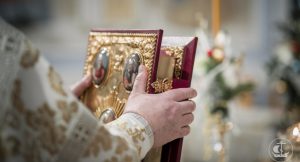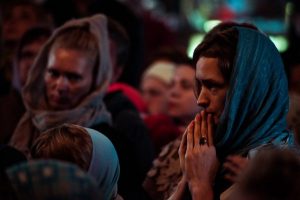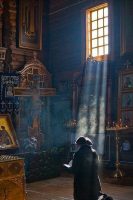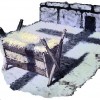She wears a cloak in my mind, and the cloak is more than an outer garment given to her by the monk Zosimas when he stumbles across her wandering in the desert. She wears the cloak throughout the story recorded for us 100 years after her death in 522 by St. Sophronios, Patriarch of Jerusalem, in the seventh century. I see this cloak as she approaches the church in Jerusalem with a heavy heart and stops on the doorstep. St. Mary of Egypt freezes on the threshold of the church repelled by unseen forces within her heart, while others around her rush toward the cross. This image shared by St. Sophronios lingers in my mind:
“But in vain I struggled. Again my feet trod on the doorstep over which others were entering the church without encountering any obstacle. I alone seemed to remain unaccepted by the church. It was as if there was a detachment of soldiers standing there to oppose my entrance. Once again I was excluded by the same mighty force and again I stood in the porch.”
Turning, with tears in her eyes, she offers a prayer before an icon of the Theotokos. Her words recorded here by St. Sophronios:
“Thus I spoke and as if acquiring some hope in firm faith and feeling some confidence in the mercy of the Mother of God, I left the place where I stood praying. And I went again and mingled with the crowd that was pushing its way into the temple. And no one seemed to thwart me, no one hindered my entering the church. I was possessed with trembling, and was almost in delirium. Having got as far as the doors which I could not reach before — as if the same force which had hindered me cleared the way for me — I now entered without difficulty and found myself within the holy place. And so it was I saw the Lifegiving Cross. I saw too the Mysteries of God and how the Lord accepts repentance. Throwing myself on the ground, I worshipped that holy earth and kissed it with trembling. Then I came out of the church and went to her who had promised to be my security, to the place where I had sealed my vow.”
St. Mary offers another prayer to the Theotokos and receives this direct guidance:
“If you cross the Jordan you will find glorious rest.”

Into the Desert
She departs on a difficult journey away from herself and toward God, and this journey lasts for nearly a half century. St. Mary of Egypt struggles in the desert alone with God; the desert is the setting for a long journey toward her heart. She fights the demons within herself, while receiving strong nourishment and consolation from God. Without distractions from the world, the Word of God resonates within her heart. When she encounters the monk Zosimas he tosses her his cloak. After years alone with God, her body and soul lie naked and exposed to the Kingdom of God.
“Believe me, I have not seen a human face ever since I crossed the Jordan, except yours today. I have not seen a beast or a living being ever since I came into the desert. I never learned from books. I have never even heard anyone who sang and read from them. But the word of God which is alive and active, by itself teaches a man knowledge. And so this is the end of my tale. But, as I asked you in the beginning, so even now I implore you for the sake of the Incarnate word of God, to pray to the Lord for me who am such a sinner.”
In the desert the will of God is magnified, and there St. Mary of Egypt finds peace (“glorious rest”) within her heart. With a pure heart, the Light penetrates directly through the windows of her soul; she has shed her heavy outer garments. The quiet forces within my heart go unnoticed while I scamper though life at high speed, and while wearing heavy outer garments the Light cannot penetrate my soul. My journey into the desert does not involve travel across the Jordan, but a journey within my own heart. In this desert of my soul, the will of God is magnified. For a long journey within, I must shed my thick cloak and replace it with a transparent garment. Without a heavy outer garment around my soul, I will see the Light shine bright in the clear desert sky.


















